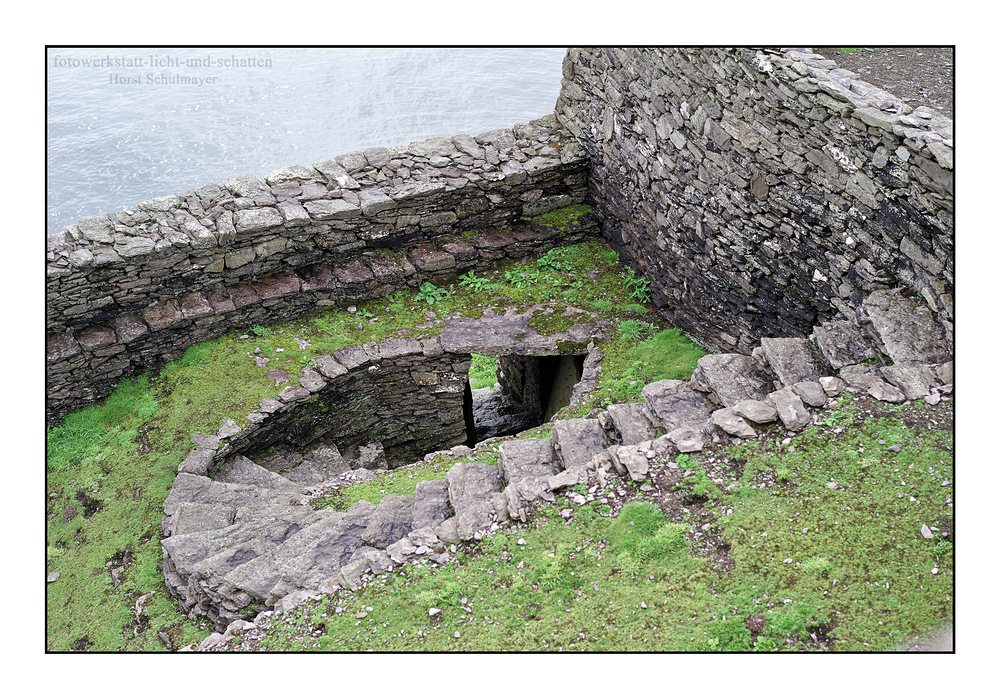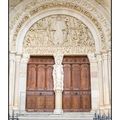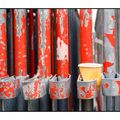Raumspartreppe
Skellig Michael - 21
Legend ascribes the founding of the monastery to St. Fionan, who lived in the sixth century.[3] The earliest documentary reference to the monastery is an entry in The Martyrology of Tallaght , written near the end of the eighth century by Máel-ruain (d. 792) in his monastery near present-day Dublin. It commemorates the death of a monk of Skellig called Suibni (Suibni in Scelig ).[4] To be acknowledged in this manner in the festology of one of the most celebrated monasteries of Ireland, located at the opposite side of the country, Skellig Michael must have been a well-established and widely known monastic settlement. The monastery there may well have been founded as early as the sixth or seventh century, but in the absence of documentation more precise dating is not possible.
The monastery is referred to simply as Skellig in the eighth- and ninth-century entries in monastic festologies and annals (The Martyrology of Tallaght , the Annals of Ulster , and the Annals of Inisfallen ). Sometime after the tenth century the monastery became known as Skellig Michael. It is likely that in the late tenth or early eleventh century the monastery was dedicated to St. Michael.[5] This is suggested by two references to the monastery in the Annals of the Kingdom of Ireland by the Four Masters . The first reads "Age of Christ, 950. Blathmhac of Sgeillic died"; the second, which reads "The Age of Christ, 1044. Aedh of Sgelic-Mhichil," is the first reliable mention of the name Michael in the annals.[6] On this basis we assume that the dedication to Michael took place between 950 and 1044. It was customary in a monastery to build a new church to celebrate a dedication, and the oldest part of the church now known as St. Michael's fits architecturally into this time period. With its mortared straight walls and large stones, the church is unlike the dry-stone corbeled oratories and beehive cells built earlier at the monastery.[7]
The church of St. Michael was mentioned in The History and Topography of Ireland , by Giraldus Cambrensis, who was in Ireland with the Normans in the late twelfth century (1183 and 1185). His account of the miraculous supply of communal wine for daily mass in St. Michael's church implies that the monastery of Skellig Michael was in constant occupancy at that time.[8]
In the thirteenth century, living conditions on the Atlantic islands of Ireland degenerated to such a degree that year-round occupancy of the island probably became impossible. A general climatic deterioration, linked to a southern shift of the circumpolar vortex, began around 1200, and as a result the polar ice cap expanded.[9] Colder weather and the increasing frequency and severity of sea storms appear to have forced the monks to withdraw to a site on the mainland on Ballinskelligs Bay, near Waterville, County Kerry.
Historical as well as climatic reasons explain why in later centuries the monastery of Skellig Michael never again came into full-time use. Many Irish monks, imitating the withdrawal of St. Anthony into the desert, sought a desert in the sea and founded monasteries on hundreds of islands—the Orkneys, the Shetlands, the Faeroes—eventually reaching from the coast of Great Britain as far as Iceland. The monastic ideal of going into exile for the love of
God, peregrinatio pro Dei amore , flourished in the Irish church, which was dominated by the monasteries. By the late eleventh century, however, the Irish church had begun to shift from a monastic to a diocesan structure typical of the Christian church elsewhere. At the same time, European orders of monks with no tradition of island monasticism, like the Canons Regular of St. Augustine, had established themselves in Ireland. The importance of these European monastic orders increased with the Norman conquest of Ireland in the late twelfth century. The great age of Irish eremitic island colonies, typified by Skellig Michael, was coming to an end.
The monks of Ballinskelligs monastery on Ballinskelligs Bay certainly continued to maintain and use Skellig Michael. They were proud of their association with its venerable history; in fact, in later centuries the prior of Ballinskelligs was still addressed in papal letters as "Augustinian prior of St. Michael's, Roche (de Rupe )." The Augustinians must have used the island intermittently, perhaps as a summer retreat. They must also have been actively involved with the pilgrims who visited the island. Skellig Michael remained in the hands of the Ballinskelligs monks until 1578, when because of the Desmond Rebellions, Queen Elizabeth I dissolved certain monasteries that were under the protection of the Earl of Desmond. At this time the island passed into private, secular, hands, where it remained until 1820, when the Corporation for Preserving and Improving the Port of Dublin, predecessor of the Commissioners of Irish Lights, purchased the island and erected two lighthouses on its Atlantic side. These were made accessible by an improved landing on the east side and a road that was blasted out on the precipitous southern flank of the island (visible in Fig. 8 and Map 2).[10]
This study describes some findings of the last few summers on the peak across the valley from the monastery. This peak, in reality the western peak of the island, has almost invariably been called the South Peak in literary references; preferring geographic to historical confusion, we will continue to use the term South Peak.
We discovered that a hermitage had been constructed on this peak during the known full-time occupancy of the island, that is, between the eighth and thirteenth centuries. One monk left the motherhouse to live as a hermit on the heights of the island's other peak.
http://publishing.cdlib.org/ucpressebooks/view?docId=ft1d5nb0gb&chunk.id=d0e611&toc.depth=1&toc.id=&brand=ucpress

Der Aufstieg
Horst Schulmayer










spacelilly13 14. November 2013, 18:35
War sicher ein anstrengende und interessante Reise, danke für die Eindrücke! Sehr spitze! Liebe Grüße MariaGeorges Vermeulen 11. November 2013, 19:08
Auch sehr interessant...!Gr Georges
deha 11. November 2013, 12:29
es gibt immer einen Ausweg... VG, DetlefJ.Kater 11. November 2013, 6:13
Stark alles in Handarbeit angelegt!Horst Schulmayer 10. November 2013, 23:06
@Sigrun Binder: Ja, genau das war mein Empfinden beim Aufnehmen dieser Bilder ... ich habe noch viele andere verlassene Orte, zum Teil auch Inseln, besucht und war von dieser elementaren Einfachheit im äußeren Leben tief beeindruckt. Umso tiefer scheinen der Humor und die selbstlose Herzlichkeit dieser Menschen in ihrer Seele erlebbar zu sein.E. W. R. 10. November 2013, 22:41
So ist es. Das wird hier oft verwechselt. ;-)Horst Schulmayer 10. November 2013, 21:59
@Eckhard Meineke: Danke Dir ... Niemand wird zu etwas gezwungen und ich verkaufe nix :-)E. W. R. 10. November 2013, 19:42
Wer lesen kann und will, der wird auch lesen. Wer lesen kann, aber nicht will, der nicht. Wer Englisch kann, versteht es. Wer nicht, der nicht. ;-)heide09 10. November 2013, 19:05
Sehr eigenwillige Bauweise finde ich die ihren Reiz aber zeigt.Gruß
Ania
Norbert REN 10. November 2013, 17:42
Diese Orte üben auf mich immer eine ganz besondere Faszination aus, und man fängt an, genau zu beobachten, und versucht in Gedanken zu rekonstruieren, aber man spürt auch die Kraft, die von diesen Orten ausgeht.Zur Bildunterschrift muss ich Dir sagen, das ich den Beitrag für medial überfrachtet halte.
Ich habe gute Erfahrungen mit einigen selbst verfassten Sätzen gemacht habe, auf Deutsch natürlich, die werden dann wenigstens auch gelesen.
LG. Norbert
Ernst Heister 10. November 2013, 17:33
Die wussten sich jedenfalls zu helfen, interessant gelöst....Grüße, Ernst
enner aus de palz 10. November 2013, 14:50
Bei der Steile des Geländes, wahrscheinlich die beste Lösung, wirklich erstklassig, was du hier präsentierst.VG Rainer
Anne Rudolph 10. November 2013, 13:49
So alt und trotzdem noch so gut erhalten.Die wußten damals gut zu bauen
lg anne
Armand Wagner 10. November 2013, 13:33
Respekt für die, die dies errichtet haben !!Feine Perspektive !!
LG Armand
Markus 4 10. November 2013, 12:57
toll, was es da so alles zu entdecken gibtHabedieehre
Markus